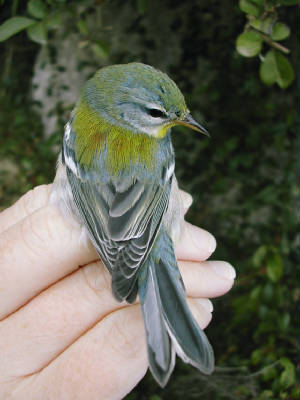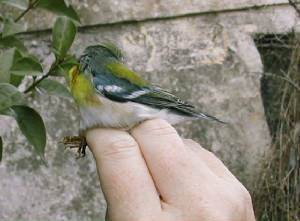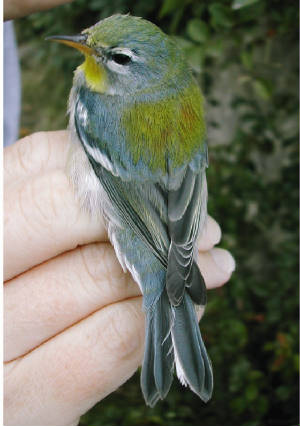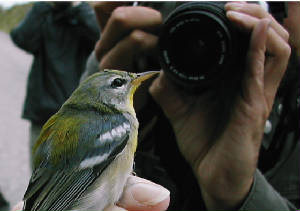|


This bird (a 1st-year male) was found around 11 am in the main garden
on the headland, where mist-nets were set for bird-ringing. It was netted about an hour later, and a description, biometrics
and photographs were taken of the bird in the hand. It was seen by eleven birders before it was released back into the
garden, where it showed briefly while perched in a Sycamore. Unfortunately, it was not subsequently seen, despite
the presence of several dozen other observers who arrived later.
Age, sex and biometrics:
Reference to Pyle’s in-the-hand guide (1997) showed that the bird was a 1st-year (as expected), based on green edgings
to tertials, worn inner two tertials, and pointed/tapering tail feathers; in photos, possibly some contrast between (duller?
retained juvenile?) primary coverts/alula and new greater-coverts, but not explicitly noted at the time. (Blue on tail – obvious in photos at least - appears to contradict Pyle, who implies this is an adult
feature.) Obvious though untidy orange/rust through the yellow breast, and long
wing, confirmed a male. Wing-length of 63 mm (flattened & straightened) was near upper range quoted for males
by Pyle (53-64 mm) but latter is 'natural chord' method used in US thus could be higher. Weight of 8.2 g fell within
range of 7.1-10.2 g quoted by Curson et al (New World Warblers). There was no visible fat in the tracheal pit or over
the abdomen (also seen on most Goldcrests and some Chiffchaffs & Blackcaps netted at Brownstown Head during October 2003),
but the bird did not seem to be in poor condition, indeed was alert and lively.
General description: See also photographs attached; features apparent from photos but not certainly noted in field/in-hand
views are noted as such.
Size/structure: Obvious warbler-type, but small and delicate compared with typical
New World warbler - perhaps only marginally bigger than a Chiffchaff. Based on by tarsus-thickness, I used the smallest ring-size (AA), as for Willow/Chiffs. Tail strongly cleft; pointed feathers. Long primary projection. Fine, medium-short bill, but apparently longer than Chiffchaff.
Call: A quiet, cold, high-pitched ‘sit’ or similar.
Soft parts: Legs & feet pale-to-mid
orangeish-brown, perhaps similar to Willow Warbler. Paler soles evident in some photos.
Upper part of upper mandible of bill dark but obvious, yellowish-horn cutting edges matching pale lower mandible (giving
impression of longer bill in some photos). ‘Large’, dark eye but emphasised by broad pale eyering; no pale orbital
(soft-part) ring noticed in hand, and no impression of this from photos.
|
 |
|
|
|
 |
|


Plumage: Upperparts: General impression in initial field view was of pale but strong bluish or blue-grey
background, with some green on crown and mantle but not obvious; in hand & in-hand photos, more obvious green ‘overlay’
over most of crown and (most strongly) mantle, with some orange or rusty tones admixed (both orangeish and green possibly,
in part, ‘structural’ colours, varying in obviousness and intensity as angle of view changed.) Head-pattern: Broad, greyish-white, broken eyering,
broken broadly in front of and behind eye; in photos, eyering whitest along the tight row of small feathers immediately eye
above and below. Blue/grey ear coverts, with little or no green visible in photos.
Upperwing: Broad white wingbars across median and all except inner two greater coverts, in initial field view about
as striking as on Chaffinch. In photos, greater covert bar mainly comprises distal
half of outer webs of most feathers, otherwise gcs appear to be dark-centered with broad bluish fringes, median-cover bar
made up of mainly-white feathers, lesser coverts bluish or blue/green. Primaries
and secondaries mainly dark grey, with narrow blue/green or blue/green-grey outer edges.
Tertials similar, green-edged but no strong contrasts, and “no pale fringes” noted in hand though photos
suggest some contrast with paler, extreme outer edges of largest two tertials. Underparts: Strong yellow chin (in photos, yellow of chin merges with pale underside of bill),
throat and (most of?) breast, with untidy, ill-defined chest-band of pale rusty feathers through the yellow. In some photos, ill-defined rusty tones also evident on throat and lower on sides of breast and also some
extension of blue-grey onto breast-sides near bend of wing. Lower breast to undertail
coverts pure white or slightly off-white (in some photos, flanks appear to have slight pale grey and yellowish or buffish
suffusion).
This was Ireland's third record of Northern Parula, and Co Waterford's
first. Three previous American passerines have been recorded at Brownstown Head: Red-eyed Vireo in 1985, Blackpoll Warbler
in 1993 and Yellow Warbler in 1995, all in October. The Vireo, Yellow Warbler and Parula were all in the same garden.
Previous Irish records:
- 1st-year male, Firkeel (Co Cork), 19-24 Oct 1983.
- Female, Dursey Island, 25 Sept 1989.
PMW
|
 |
|
|
|

